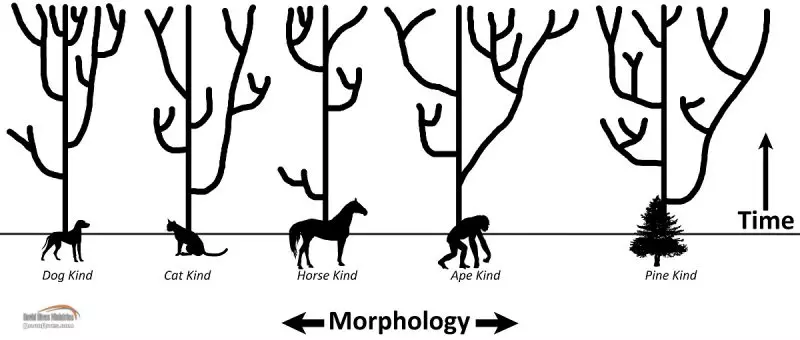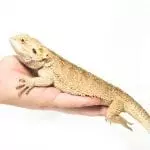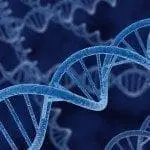[Originally published as Junior High: Life Science]
LIFE SCIENCE IN CALIFORNIA
EVOLUTION TOPICS COVERED IN THIS TEXTBOOK:
This textbook includes over 100 pages (of about 700 pages total length) dedicated to evolution theory. Most of the evolution teaching is included in Chapters 7 and 8, which include a ground-up presentation of Darwinian evolution (chapter 7) followed by a lengthy argument for the age of the earth (chapter 8) and the various dating methods that supposedly prove evolution in the fossil record. Each section is covered below.
Chapter 7: Darwin’s Theory of Evolution (pp. 220-231)
Pages 220-221 of the textbook defines a theory as a guess, or an idea of how or why something might happen. It also states that a huge amount of evidence supports the theory of evolution. However, if one studies the evidence, it soon becomes clear that evolution is impossible scientifically.
First, let’s define a theory in a better way than the textbook describes it. “A theory has its genesis in a hypothesis, which is a working assumption as to why we observe something—an educated guess. To test this assumption, scientists conduct experiments that either disprove or correlate with the hypothesis.
Many theories, however, don’t last forever. If new technology allows better experimentation, for example, a theory may need to be discarded. Two problems prevent evolution being called a theory. First, there is no direct, observable experiment that can ever be performed to prove it. Scientists can measure bones, study mutations, decode DNA, and notice similarities in morphology (the form and structure of animals and plants), but they can never test whether creationists reject science.
Secondly, evolution misses the mark as a theory because all of the supposed “tests” to prove the theory do not necessarily correspond to the idea. In other words, each has an alternate and equally viable explanation (like creation). A theory requires that the confirming experiments correspond to one specific hypothesis. Otherwise, the experiment cannot prove something’s true of false. So therefore by definition of a theory itself, “Evolution is [actually] anti-science and anti-knowledge” (Lisle, 2008).
Works Cited:
- “Evolution: Not Even a Theory.” Answers in Genesis. N.p., n.d. Web. 25 June 2014.
- Lisle, Jason. “Evolution: The Anti-science.” Answers in Genesis. N.p., 13 Feb. 2008. Web. 25 June 2014.
CHAPTER 7: DARWIN’S THEORY OF EVOLUTION – ADAPTATION (PP. 227-228, 243, 307)
This section in the book states that a new species can form when a group of individuals remain isolated from the rest of its species long enough to evolve different traits through adaptation and natural selection. Adaptation is a widely used concept by evolutionists when describing the Darwinian evolution, but they leave out very important factors which debunk their claims that this process is occurring.
For example, the different size and shapes of the finches described in the text shows adaptation and variation, but does not show any signs of evolution as described by Darwin. Let me break this down to explain the concept more. The different shape and size of the beaks allow the finches to live and prosper in certain environments. Birds with thicker beaks can live on islands that have thick shells, but the ones with long and skinny beaks will not be able to survive as easily. Over time, the trait of a long and skinny beak will become dormant within the genetic code and will show up less over time.
This shows genetic adaptation but most definitely not evolution. “The size of beaks goes up and down over the years, but it never permanently changes, and it certainly does not change into something other than a beak. In order for this to be ‘evolution in action,’ we should see some type of new physical feature or biological process” (Biddle, p. 140, 2014). Through adaptation you will never observe a change in kind, which is needed if the concept of adaptation was to support the evolution theory.
The finch is still a bird, and the different size beaks are still beaks. “Observational science supports this type of subtle change within a kind but not molecules-to-man evolution” (Patterson, p. 61, 2009).
Works Cited:
-
- Patterson, Roger. “Natural Selection and Evolution: Do Darwin’s Finches Prove Evolution?” Creation V. Evolution. Ed. Daniel A. Biddle. N.p.: Xulon, 140. Print.
- Patterson, Roger. “Natural Selection vs Evolution.” Evolution Exposed. Petersburg, KY: Answers in Genesis, 61. Print.
CHAPTER 7: EVIDENCE OF DARWINIAN EVOLUTION – HOMOLOGOUS STRUCTURES (P. 235, 256)
In the textbook, homologous structures are similar structures that related species have supposedly inherited from a common ancestor. This definition is flawed and in no way does it prove Darwinian evolution. If the bones in the limbs of dolphins, birds and dogs all had a common ancestor as evolution teaches, then “we should be able to trace these alleged homologies to the DNA that codes for them” (Bergman 2001). In other words, if the structures of the organisms are homologous through evolution, then the genes in the DNA that make these characteristics should be in the same location within the DNA of these different organisms.
As technology has advanced, geneticists have been able to identify the specific genes that make these specific characteristics. Through further analysis, they found that “what are labeled as homologous structures in different species often are produced by quite different genes” (Bergman, 2001). “When structures that appear to be similar to one another develop under the control of genes that are not related, the common ancestor idea fails” (Patterson, p. 70, 2009) because “if the Darwinian interpretation of homology were correct, then we would expect that the same homologies found at the macroscopic level also exist at the microscopic, biochemical and genetic levels” (Bergman, 2001).
Bergman continues: “Examples of homology are actually better explained by analogy, and the resemblance that exists is often due to similarity of function and/or design constraints. The forelimbs of humans, whales and birds are similar because they serve similar functions and have similar design constraints” (Bergman, 2001). A “valid is that all these organisms were created by a common Designer who used the same design principles to accomplish similar functions” (Patterson, p. 70, 2009). In other words, why would God want to re-invent the wheel every time He made a similar function between animals?
“Homology is a failed proof of evolution. If Homology were true then creatures that have similar features would produce those features through a similar genetic pathway. A simple analogy: bikes, cars, and planes all share a homologous feature—tires. But the tires they share are all produced by a different factory, using different materials and under different conditions. The same thing is true for similar features in different animals. The features make look similar but they are produced by completely different genetic pathways. So there is no possibility that the homologous features are anything but superficially alike.” (Darrin Clinton, 2014, personal correspondence).
Works Cited:
Bergman, Jerry. “Does Homology Provide Evidence of Evolutionary Naturalism?” Journal of Creation 15.1 (2001): 26-33. Answers in Genesis. Web. 25 June 2014.
Patterson, Roger Todd. “Natural Selection vs Evolution.” Evolution Exposed. Petersburg, KY: Answers in Genesis, 2009. 70. Print.
CHAPTER 7: EVOLUTION OF THE SPECIES – COMMON ANCESTORS, BRANCHING (PP. 245, 255)
The book teaches that evolutionary relationships among organisms show the order in which specific characteristics may have evolved. For example, page 245 of the text shows an “evolutionary tree of life” stating that raccoons, lesser pandas, giant pandas, and bears all came from a common ancestor around 40 million years ago.
When you observe this illustration, ask yourself, “What direct evidence supports the lines on this tree?” “A major problem with [these] trees and other related models is the lack of evidence that supports the links between known organisms and their supposed fossil relatives. The lines that connect an ancestor to the living organism are mostly imaginary” (Patterson, p. 38, 2009).
Creationists disagree with this proposed “tree of life” that all life originated from a single, unknown, common ancestor. Now this does not mean that creationists disagree with the “classifications by evolutionary biologists but [the] evolutionary history associated with the classifications is rejected” (Patterson, p. 39, 2009). Throughout time, scientists have observed the rise of new species, but they are always within the limitation of their created kinds. They have never witnessed a new kind arise which would be necessary if this proposed tree of life in evolution theory were to be true.
If we begin our thinking from the Word of God, as we should if we are to honor Christ, we have a very different way of interpreting the evidence. God describes how He created living things in the first chapter of the Bible—Genesis 1. He tells us, as an eyewitness to His own work, that He created plants and animals according to their kinds to reproduce after their kinds.
Genesis 1:11 makes this clear: ‘Let the earth bring forth grass, the herb that yields seed, and the fruit tree that yields fruit according to its kind, whose seed is in itself, on the earth.’
God supernaturally and specially created the different kinds of plants with seeds to produce more of the same kind. A coconut will never sprout a plum tree. The passages describing animals teach the same thing (Genesis 1:20–25; 6:19–20). So rather than a single tree of life, we could draw an orchard of trees each representing a distinct kind of plant or animal. All of the branches on the tree represent the variation within those kinds that have resulted from different expressions of the initial genetic variation God programmed in the original organisms as well as later mutations and other forms of genetic mixing.
This orchard model is also an idea developed from a certain philosophy- Biblical creation” (Biddle, p. 142-143, 2014).

Works Cited:
- Patterson, Roger. “Natural Selection and Evolution: Do Darwin’s Finches Prove Evolution?” Creation V. Evolution. Ed. Daniel A. Biddle. N.p.: Xulon, 2014. 142-43. Print.
- Patterson, Roger Todd. “Classifying Life.” Evolution Exposed. Petersburg, KY: Answers in Genesis, 2009. 38-39. Print.







